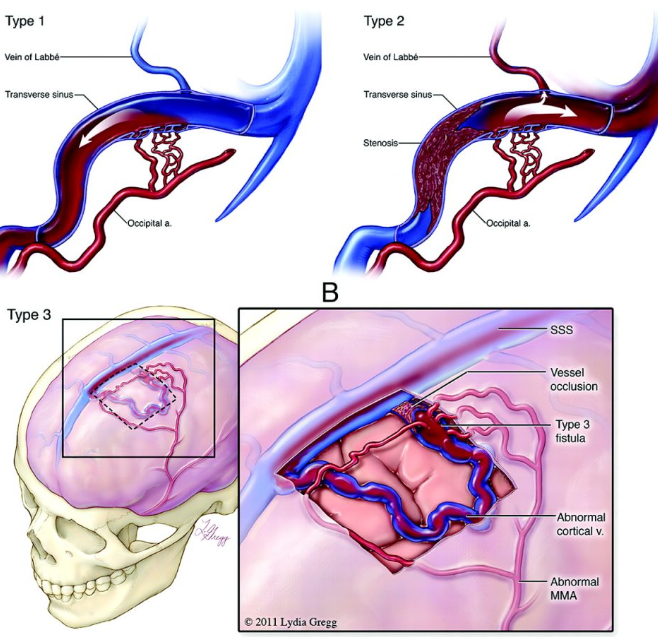Dural AVF
Dural Arteriovenous Fistulas
Dural arteriovenous fistulas (dAVFs) are abnormal connections between an artery and a vein in the tough covering over the brain or spinal cord (dura mater).
In this rare condition, abnormal passageways between arteries and veins (arteriovenous fistulas) may occur in the brain, spinal cord or other areas of your body.
Symptoms:
Some people with a dAVF may not have any symptoms. However, noticeable symptoms can be characterized either as aggressive or benign.

- Difficulty walking, falls
- Seizures
- Speech or language issues
- Facial pain
- Dementia
- Parkinsonism
- Coordination issues
- Burning or prickling sensations
- Weakness
- Apathy
- Failure to thrive
Symptoms related to increased pressure such as headaches, nausea and vomiting.
Other dAVF symptoms can include hearing issues, such as a bruit behind the ear, also known as pulsatile tinnitus.
Other symptoms include vision problems such as:
- Visual deterioration
- Eye bulge
- Swelling in the eye lining
- Eye-related palsies
- Cavernous sinus syndrome.
- In rare cases, progressive dementia may occur due to venous hypertension.
Diagnosis:
CT head : These tests can show fluid buildup caused by heightened cortical vein blood pressure as well as actual bleeding, which may be caused by a dAVF but occur elsewhere in the brain’s venous system.
MRI : These images can establish the shape and extent of a dAVF, detect any micro-hemorrhages (very small bleed locations), and determine the impact of any abnormal blood vessel structures related to the fistula itself.
Angiography : Catheter-based cerebral angiography (also known as digital subtraction angiography) is still the most reliable and definitive tool on dAVF diagnosis.
It’s essential for defining:
- How many fistulae exist and where
- Anatomy of the external carotid arteries and any branches between them and the dura
- Fistula blood vessels’ structure
- Whether cardiovascular disease is also present
- How much narrowing or blockage has occurred in the dural sinus
- Whether any affected veins are dilated and to what extent
- Superselective angiography may also be required to identify the area of convergence of the feeding dural arteries and the origin of the draining vein.
Treatment:
Treatment for dural arteriovenous fistula generally involves surgery to block or disconnect the fistula.
Endovascular procedures : In an endovascular procedure, your doctor may insert a long, thin tube (catheter) into a blood vessel in your leg or groin and thread it through blood vessels to the dural arteriovenous fistula using X-ray imaging. Your doctor inserts the catheter into the blood vessel that leads to the dAVF and releases coils or a glue-like substance to block the abnormal connection in the blood vessels.
Stereotactic radiosurgery : In stereotactic radiosurgery your doctor uses precisely focused radiation to block the abnormal connection in the blood vessels. The high dose of radiation delivered to the fistula causes blood vessels to close off, destroying the dAVF. The different types of technology used to perform dAVF stereotactic radiosurgery include the linear accelerator (LINAC), Gamma Knife and proton beam therapy.
dAVF surgery : If an endovascular procedure or stereotactic radiosurgery aren’t options for you, you may need dAVF surgery. Surgery may be performed to disconnect the dAVF or cut off the blood supply and remove the fistula.
Looking for Neuro
Surgeon?
Simply give us a call and book an appointment for yourself. We are here to help. Walk into our Hospital and let us take a closer look to suggest the best treatment you need.
